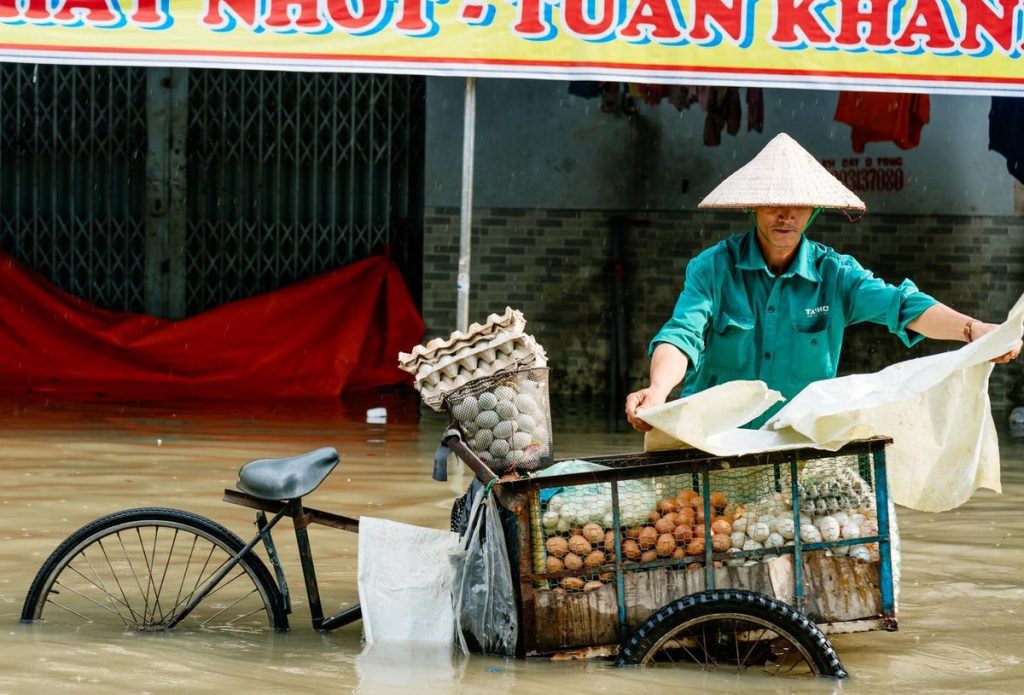This is the second in a series on river deltas and food production. In the first post, I focused on how rivers create deltas and how deltas often provide ideal conditions for agriculture. Overall, deltas produce 4% of the world’s food on just 0.5% of its land.
But today, deltas are at a crossroads. At the beginning of the 20th century, most deltas had been expanding for thousands of years. But in a geologic blink of an eye, many of the world’s largest deltas have begun to sink and shrink.
This delta degradation has many causes. Of course, sea levels are rising – and that alone would contribute to erosion and inundation of parts of deltas. But in addition to the sea rising, deltas are dropping. Pumping of groundwater and compaction of delta surfaces can lead to a lowering of delta elevations. But the most fundamental driver of delta decline has to do with the loss of sediment in the rivers that flow into deltas.
Deltas have always existed in a tenuous equilibrium between land and water, a dynamic dance between river, sediment, and sea. The deposition of sediment, described in the first post, builds deltas up and expands them outward, while storms, erosion, and compaction cause deltas to degrade. If a river continues to deliver sufficient sediment, its delta can maintain or expand its elevation and extent.
But in much of the world, rivers are not continuing to deliver sufficient sediment. The capture of sediment in reservoirs behind dams is a major reason for this loss of sediment.
Just as a river slows and drops its sediment when it reaches the sea, a river will also slow and drop its sediment when it enters a reservoir behind a dam. Within large reservoirs, only the smallest sizes of sediment can pass through, while most sediment is trapped within the reservoir.
With 50,000 major dams worldwide, people have become a globally significant geological force affecting the movement of sediment. Reservoirs trap approximately ¼ of the global annual flux of sediment—sediment that would otherwise reach deltas and the ocean—and, cumulatively, more than 100 billion metric tons of sediment have been captured behind dams.
In an article with an extremely concise and direct title for a scientific paper, “Sinking deltas due to human activities,” a research team identified a number of deltas considered to be in “greater peril” and most of these are deltas downstream of major dams that capture nearly all the riverborne sediment. For example, the Colorado Delta’s annual sediment deposits have declined by 100% and the Nile Delta’s sediment inputs have dropped by 98%. Meanwhile the Nile Delta is home to half of Egypt’s population and the country’s most important farmland.
The capture of sediment within reservoirs can diminish the amount of new sand delivered to a delta each year, akin to a drop in the deposits of new income into your bank account. Financially, loss of income is a problem. But it’s even worse if something is simultaneously depleting your savings.
Marc Goichot of WWF uses that financial metaphor to examine the role of sand mining in the Mekong Delta, noting that “far more sand is being removed than is being replenished.”
I’ll focus on the Mekong in the next post, but the impacts from sand mining in the Mekong highlights a global challenge.
Each year, approximately 50 billion tons of sand and gravel are mined, primarily for use in construction and land reclamation. To put that number in perspective, it is approximately 25 times greater than the most heavily mined metal, iron ore. That makes the mining of aggregate, the collective term for sand and gravel, the largest extractive industry on Earth (see this animation of the figure below).
Despite the massive scope of extraction, few people are aware of sand mining and what it can do to rivers and deltas. For a delta, excessive sand mining represents the liquidation of its sediment savings account.
Sand mining extracts sand from the bed, banks, and floodplain of river channels within deltas or upstream of them. This removes the sediment that can get “remobilized” during floods to be spread across the delta. It also deepens channels, leading to intrusion of salt water and bank erosion, accelerating the erosion of deltas.
Think of the complex interactions between a river delta and the ocean as a boxing match between them. The extensive capture of sediment behind upstream reservoirs is akin to asking the delta to fight with one hand tied behind its back. Now add in unsustainable sand mining, and the delta boxer has to tie his other hand behind his back.
Oh, and the ocean is rising due to climate change, so the no-handed delta boxer is facing an ocean boxer on steroids.
Because of this loss of sediment—combined with compaction and pumping of groundwater and oil and gas from beneath deltas—heavily populated deltas around the world are experiencing increased flooding, with 85% of major deltas experiencing severe flooding in recent decades. The extent of flooding could increase by 50% with current projections of sea level rise and continued loss of sediment.
Further, some deltas, such as that of the Mekong, are now eroding rapidly and could be mostly underwater by the end of the century. Such losses of delta land would displace tens of millions of people.
In the next post, I’ll focus on the Mekong Delta as well as broader solutions for countering these rising risks to deltas worldwide.
Read the full article here









